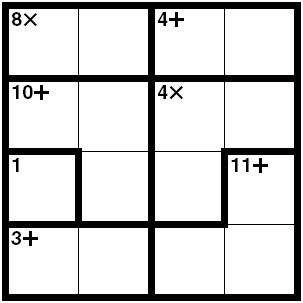
Well known puzzle creator and editor Will Shortz (New York Times) has created a very helpful little video (shown below) on a great mathematical alternative to Sudoku called KenKen. If you don’t already KenKen as they say, his demonstration is probably the easiest and quickest way to learn about these addictive puzzles. You’ll see why I say this after reading the following description.
“As in Sudoku, the goal of each puzzle is to fill a grid with digits –– 1 through 4 for a 4×4 grid, 1 through 5 for a 5×5, etc. –– so that no digit appears more than once in any row or column. Grids range in size from 3×3 to 9×9. Additionally, KenKen grids are divided into heavily outlined groups of cells –– often called “cages” –– and the numbers in the cells of each cage must produce a certain “target” number when combined using a specified mathematical operation (addition, subtraction, multiplication or division). For example, a three-cell cage specifying addition and a target number of 6 in a 4×4 puzzle might be satisfied with the digits 1, 2, and 3. Digits may be repeated within a cage, as long as they are not in the same row or column. No operation is relevant for a single-cell cage: placing the “target” in the cell is the only possibility. The target number and operation appear in the upper left-hand corner of the cage.”
Believe it or not, it all makes perfect sense once you start playing around with the puzzles. And it’s great to follow along in that video as he fills out a 3×3 grid to start. Like with Sudoku, there’s no substitute for hands on exploration, little patterns and tricks start to appear, and the subtle complexities of the puzzles become evident – guess that’s why they can be so addictive sometimes.
There seem to be so many more letter-based puzzles than ones centering on numbers. I wonder if part of that is due to a sort of inherent intimidation factor that math seems to have sometimes. I think the uncertainty surrounding arithmetic is thanks largely to it not always being made relatable during early education. It’s so conceptual, and if one can visualize what numbers represent, then it just makes sense, instead of being confusing or overwhelming.
It doesn’t help when some teachers treat math as a chore, something unpleasant that just has to be put up with. I remember one math teacher I had whose teaching approach was utterly baffling to me, both then and now. On the first day of class he opened with, “I know none of you want to be here, but we have to.” I kid you not, word for word that was my welcome to tenth grade math class. Relax and have fun would be a much better math norm. Numbers have such an inherent puzzle-like quality, they just fit together so perfectly. They can be so much fun.
That’s one thing that really excites me about the increasing proliferation of KenKen puzzles as local bookstores continue to increase their KenKen shelf space. Word games from Scrabble to Crosswords have been around for ages. Sudoku took letter play in another addictive direction. And now KenKen is doing the same for numbers. Having always loved math, the precision and logic of it, not to mention it being one of the few things we learned in school that we actually use in real life, I couldn’t be happier. As KenKen creator Tetsuya Miyamoto calls it, “the art of teaching without teaching.” The name is derived from the Japanese for cleverness, so whatever you call it, mental math, teaching without teaching, brain calisthenics, or just plain ordinary puzzle fun, KenKen really lives up to its name.
If you’re interested in learning more about KenKen, one of my favourite volumes is Will Shortz Presents Crazy for KenKen Easy to Hard: 100 Logic Puzzles That Make You Smarter. In addition to the benefit of having a range of easy to hard puzzles, Will Shortz also provides an introduction and “How to Solve” instructions. Another favourite is Will Shortz Presents The Ultimate KenKen Omnibus: 500 Easy to Hard Logic Puzzles That Make You Smarter with puzzles galore.
%CODE3%




Elizabeth,
I think you hit the nail on the head when you said, “Relax and have fun would be a much better math norm.”
Kenken is one of the best introduction to the fun and beauty of how numbers fit together. To that effect, I’ve made some free videos about how to solve a basic 4×4 Kenken, as well as an advanced 9×9 KenKen in which the operation signs are not given.
You can check them out at:
http://mathmojo.com/kenken/
Go figure,
Brian at http://mathmojo.com/chronicles